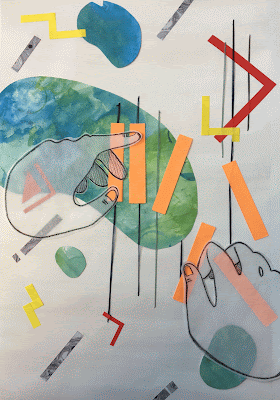End of Module Student Evaluation
Learning Outcome
|
Evidenced
where?
Blog,
Sketchbook, Roughs Final Illustrations, development sheets etc. (No more than 75 words)
|
Your
grade
Using words:
> poor,
satisfactory, good, very good, excellent
|
4A7
Demonstrate an
understanding of the relationship between visual language, visual
communication and problem solving in the development of appropriate solutions
to defined problems.
|
Sketchbook, roughs, development sheets
|
Good
|
4B6
Demonstrate a critical awareness of individual
intentions in the production and contextualisation of work related to
appropriate creative practices in illustration.
|
Sketchbook, blog
|
Good
|
4C8
Identify, evaluate and select appropriate
practical and conceptual approaches to the development of visual solutions to
set problems.
|
Sketchbook, roughs, blog
|
Good
|
4C9
Demonstrate the ability to incorporate visual
skills and sensitivity to appropriate media in the development of a body of
individually identified responses to set briefs.
|
Sketchbook, final illustrations
|
Good
|
4D6
Effectively manage time and resources in order
to document, present and evaluate a self-determined body of work in response
to set briefs.
|
Blog
|
Good
|
This
particular module taught me beyond just creating images or illustrations. I
would say that effectively visually communicating a concept or a message was
the ultimate challenge. There was so much thought, planning and process
involved for each set briefs. I suppose solving a design problem is something
that I learnt and it is a skill that I hope to further develop on.
I personally
think that I had invested most of my time and attention in this module in
comparison to the previous ones. Perhaps it was due to my interest towards
the briefs and actually being able to show my own practice through my work. I
would say that I was most satisfied with the Persons of Note brief, from the
process to the final outcome. I thought that the experiments and test pieces
helped a lot in terms of trying to communicate my intentions through visual
means. Usually it took me a while to get my head around briefs, though it
made more sense when I actually started doing practical work. I was glad to
have spent time and energy developing as I get to find out both successes and
faults with ideas or methods, working my way from those trial and
errors.
Throughout the
module, there often cases where I change my mind or certain designs after
speaking with peers or coming across new things from research. Though I would
say that research was an effective way of working, not only through online
sources or books but also from doing field research. For instance, with the
Persons of Note, I spent some time outside creating sound maps. I realised
that there is a difference between doing secondary research and actually
observing as well as experiencing something first hand. Personally I feel
that by observing things, I subconsciously try to make sense of it and
reflect upon how it could help with my practice; there is just more thought
put into it. But also, I found feedbacks really helpful and even simple conversations
with friends. Usually the comments and things stated made me look at my own
work at a different angle and ways in which I never thought of. I suppose it
is that constant self-reflection and questioning that helped me develop my
work.
Contextual
research had been helpful throughout the module. Generally, I look at elements
such as use of colour, composition and how they express tone, mood as well as
communicating through imagery. For instance with the Act of Kindess brief, I
was generally inspired by an exhibition I visited, which talked about social
and cultural issues. Though despite the various ways of communicating that
subject matter, these practitioners had used universal symbols and imageries.
I thought that it was clever and effective as they used elements recognisable
to the audience. As I have come to realise that I like to work with shapes
and colours, I had been thinking a lot about how I could communicate messages effectively through visual means.
I am generally
satisfied with the things I had done and learnt from this module. Even though
I explored different approaches, I feel that I am still working within my
comfort zone. For the last brief, I tried going bigger, work looser and less
constricted to focusing on details. It wasn’t something I am used to, but
surprisingly I enjoyed the space to simply explore. I thought that it was
useful trying things out first and then extract certain elements or method of
working to further develop them into final pieces.
|






















